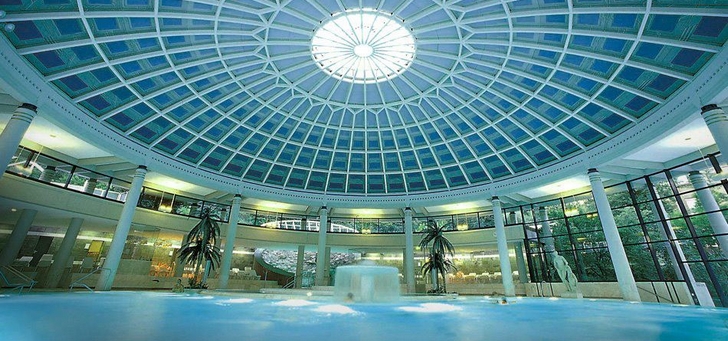Will eleven European spa towns with prestigious architectures soon be recognized by UNESCO?
Discover the most emblematic thermal establishments of the "Great Spas of Europe" initiative!

In 2014, several European countries joined forces under the name “Great Spas of Europe” to valorize their hydrotherapy history and obtain UNESCO (1) recognition for their uniqueness. This proposal for inclusion in the World Heritage List will be discussed in 2020. Iconic for the continent’s architectural know-how, we invite you to familiarize yourself with them as they may –perhaps– be awarded a new label!

Read also: Flashback to the design and architectural swimming pool changes in the 20th century
Great Spas of Europe – a bold step to promote hydrotherapy
The purpose of this joint project is to conserve and highlight the heritage of these spa towns and, at the same time, contribute to their promotion internationally and facilitate transmission to future generations. In reality, it is a question of promoting the culture and history related to European hydrotherapy, a rediscovered approach to health care, the prestigious urban developments to which it gave rise and to spotlight these places which impacted European history in the 19th and early 20th century. A dedicated website explains this initiative in detail.
The prerequisite for the inscription of each spa town in the seven countries concerned is their “Exceptional Universal Value” (EUV) and the fact that they meet at least one of the ten UNESCO criteria. Currently, each meets four criteria:
- influence on modern European cities for a given period or in a given cultural surface (criterion II);
- contribution of a unique or exceptional testimony to a living or past cultural tradition or civilization (criterion III);
- a unique urban typology illustrating one or several significant periods in human history (criterion IV);
- vectors of transnational culture (criterion VI).
If the application is approved, these spa towns will be awarded a new label enabling them to extend their influence – and their business. The architecture of these spa towns is one of the essential criteria for obtaining this coveted label. We review it – and them – below!
Hydrotherapy history: meet some architectural marvels in emblematic European spa towns
Bad Ems, Baden-Baden, Bad Kissingen - Germany

© CARASANA Bäderbetriebe GmbH - Friedrichsbad
It is hardly surprising that these German spa towns attracted artists! They all date back to Roman times with traces still visible today and many are treasures of civil engineering. In Baden-Baden, Friedrichsbad thermal spa, built in a neo-Renaissance style in 1887, is considered to be one of the most beautiful thermal baths in the world.
Baden bei Wien - Austria

© Badener KurbetriebsgesmbH - Römertherme Baden
This sulfurized water spa town was burnt to the ground at the beginning of the 19th century. Baden bei Wien was then rebuilt by architect Joseph Kornhäusel in the style of Biedermeier, an alternative to neoclassicism. Several baths were added in the course of time, including the Römertherme Baden, an example of perfect architectural balance between the Biedermeier and modern style!
Spa - Belgium

© Thermes de Spa
Nicknamed the “Café of Europe”, the influence of the thermal city of Spa is such that its name is used to describe wellness centers and baths in general. Its water was sent all over Europe as early as the 16th century! Today, hydrotherapy at Spa is modernized but its origins are not forgotten. The new Spa thermal baths center is a truly gentle cocoon open onto nature, combining modern wellbeing with traditional hydrotherapy.
Vichy - France

© MangAllyPop@ER / stock.adobe.com / Thermes les Dômes
Vichy is universally recognized for the quality of its water, used both in hydrotherapy, for cosmetics and bottled mineral water. The art deco architecture of the Thermes des Dômes accounts for its magnificent pseudo-Byzantine dome. The spa became a listed historic monument in 1939. It features saunas, Turkish baths, a wellness swimming pool, water jet baths plus a salt wall and a cardio-training gym.
Montecatini Terme - Italy

© hibiscus81 / stock.adobe.com / Thermes Tettuccio
Nestled in the heart of Tuscany, Montecatini Terme is unique by its many Tuscan or Baroque travertine columns. The architecture of this spa town is bold! Although mainly focused on drinking water, some spas, like the Terme Redi, also feature thermal pools.
The Bohemian spa towns triangle - Czech Republic

© Aliaksei / stock.adobe.com / Colonnade du Moulin
The trio of spas – Karlovy Vary, Mariánské Lázně and Františkovy Lázně - are all architectural wonders! The first two spa towns are perfect examples of cosmopolitan architecture, combining historicism, Art Nouveau, neoclassic and Empire styles. Františkovy Lázně was designed as a spa town in a homogeneous mainly neoclassic style. They all feature baths with colonnades typical of Bohemia, including the famous Mill Colonnade in Karlovy Vary.
Bath - the United Kingdom

© Anthony Brown / stock.adobe.com / Thermes de Bath
For more than 2,000 years, Bath has hosted visitors “taking the waters” in the hottest springs in the country. Bath became one of the most fashionable spas in Europe and was built in a neoclassical architectural style while conserving its Ancient Roman heritage for the remarkably well-preserved bath area which visitors flock to see although they are no longer in use.
The prestigious architecture of these spa buildings is a vital factor in their worldwide fame. While awaiting the verdict of UNESCO, check out the actions undertaken by Greece to develop its tourism – and business — through hydrotherapy!
(1) UNESCO : Great Spas of Europe
© Photo credits: CARASANA Bäderbetriebe GmbH - Thermes de Caracalla

